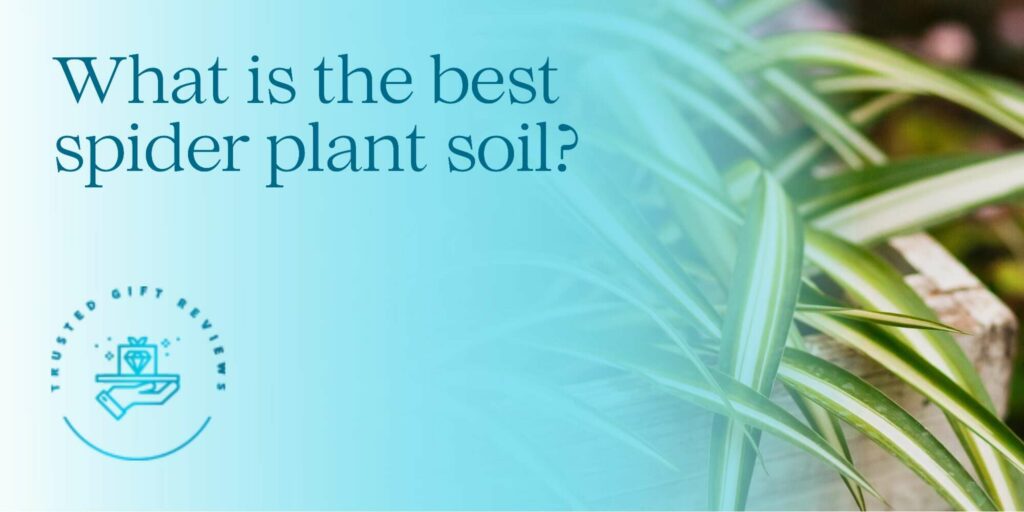Spider plants need a loamy, moist, and well-drained soil mix to grow vigorously. Also, it should be a bit acidic with a 6 to 6.5 pH level, although it can tolerate neutral soil with a pH range of 7.
It can be hard to find the perfect potting mix for spider plants sold by nurseries or florists. But you can make one yourself by mixing 4 parts of pine bark fines, 1 part perlite, and 1 part peat moss.
And, remember to plant them in a plastic or ceramic pot with drainage holes to help them to retain moisture.
With this in mind, we’ll now discuss other relevant things regarding the best spider plant care.
What will happen if I use the wrong soil?


Using the wrong soil, especially one that’s compact and doesn’t allow proper drainage, will be detrimental to your plant’s health and growth. Put simply, the plant just won’t be able to breathe and obtain nutrients through air and water normally.
The symptoms of this include the leaves wilting, curling, or browning; foliage developing spots or dropping prematurely; and worst of all, the root rotting, developing whitish mold, and attracting pests.
Oftentimes, you’ll start noticing these symptoms when you have unintentionally overwatered your spider plant. Or it can be related to placing them in an unsuitable environment lacking the proper temperature and moisture level.
What kind of soil should I use for my spider plant?


We already mentioned earlier the best soil for your spider plant. However, generally speaking, spider plants do well in organic potting soil (soil mixed with compost).
Adding perlite or pumice to the soil is always a great idea.
The first aerates the soil. The second improves soil structure, loosens hard soil, and prevents it from packing tightly together, thereby allowing water to be absorbed into the soil and drained freely.
So, don’t grow your spider plant in gardening soil because this kind of soil is dense and has poor drainage.
What water is best to use for spider plants?


Avoid tap water when watering them, but rather, only use rain or distilled water regularly to flush salt and chemical buildup in the soil.
Naturally, plants develop salt and chemicals in their soil over time. Excessive salt can damage and dry up the roots, and chemicals can contaminate the plant, thereby affecting its ability to grow.
The Best Commercial Spider Plant Soil


Should you decide to buy a commercial spider plant soil, we suggest choosing an African Violet soil mix.
It’s the best and closest soil to what the spider plants need. This commercial soil mix has well-balanced nutrients, the right pH level, and soil texture, and it will encourage the plant to produce beautiful leaves!
But if you can’t find African Violet potting mix, you can just use one that has 1 part of peat moss in it. But keep in mind that it’s not as optimal for the spider plant.
If the commercial soil you end up buying is a bit alkaline, you can correct it by adding coffee grounds. But if it is too acidic, adding dolomite or limestone should do the trick to reach the right pH level of 6 to 6.5.
Making the Perfect Soil Recipe for Your Spider Plant


It’s pretty straightforward to make the perfect soil recipe for your spider or ribbon plant.
The first step is to get an organic potting mix from your reserve or a nursery or flower shop. And then, simply mix it with the following ingredients in a large container using a trowel.
- Peat moss
- Coconut fibers
- Perlite
- Pine bark fines
- Vermiculite
Pour your new soil mix into a pot afterward.
These additional components will enhance the soil in various ways, such as improving its structure and promoting aeration and drainage.
Now that you’re perfect soil recipe is ready, take the tuber root and put it in the pot too. Moreover, make sure to cover all of the roots and top them with the same potting mix.
The Ideal Spider Plant Environment


In addition to giving your spider plant the best soil, you have to get its environment right for watering, sunlight, and humidity.
First of all, spider plants don’t like to sit in soggy or dry soil since these can harm them. They like soil with even moisture.
Next, place them in a shaded spot in your home or garden in the way of indirect light. Don’t set them where they get direct, bright sun, as this can scorch their leaves and cause spots and browning on the tips of their leaves.
Concerning temperature, spider plants thrive in a place at 60℉ to 80℉ with moderate humidity. However, it can tolerate a location that has low humidity as well.
Usually, low moisture can result in the leaves getting brown tips. So once you notice them or when you know there’s little moisture in the space, spritz the spider plant with water to hydrate it.
Repotting a Spider Plant


A spider plant grows extremely fast and can outgrow the pot they’re planted in. That makes them best to be repotted every one to two years.
The same fertile and well-draining soil mix is to be used when you begin to transfer the plant to its new home. The best time to do this is during spring or summer when it is actively growing, compared to winter when it is dormant.
Also, it’s best to repot the plant a few days after you have watered it. This way, it will find it better able to adapt to its new environment.
Propagating a Spider Plant


Unlike other plants that require you to cut leaves to propagate them, spider plants can only breed through their spiderettes.
You can tell your spider plant is about to grow spiderettes if you notice tiny white flowers. You can leave the baby plants and the mother plant together until the former develops new roots.
Once they do so, snip out the runner that connects them with the mother plant, and place the spiderettes in a lightweight potting mix.
Fertilizing a Spider Plant


If you followed the perfect soil recipe above, fertilizing this plant may not be required at all.
However, if you feel that it needs a nutrient boost, use a well-balanced liquid fertilizer. Follow the package instructions to dilute it with water for the best and safest use.
Feed it with fertilizer in its growing months between March and September every two to four weeks. But note that you don’t have to feed healthy plants as often as nutrient-deficient ones.
FAQs about Spider Plant Soil


- Can I use cactus or orchid soil for spider plants?
Because cactus, succulent, and orchid soil have the same properties as the ideal spider plant soil (which are ample drainage and a little acidity), you can use them too!
However, they’re not as great if used alone. They’re best used as supplements.
For instance, you can add orchid bark at the bottom of the pot for optimal drainage.
- How do I mix spider plant soil?
Put the base potting soil and the other essential ingredients for healthy spider plant soil in a large container.
Mix enough water to make the ingredients slightly moist. Use a trowel or any kind of stick.
Once it has been mixed thoroughly, pour the soil mix into your chosen pot vessel.
Put your spider plant roots in, and cover the roots and the top with another layer of the soil mix. And you’re all done!
- Do spider plants need big pots?
A reliable rule of thumb is that the pot you pick must be one or two times bigger than the spider plant’s root ball.
But when it grows large after a year or two, you need to repot it to a larger container to let it grow without any hindrance and with enough space for its claw-like hanging leaves.
- What is the best fertilizer for spider plants?
There are several kinds of great fertilizers you can apply to your spider plant. Among them are liquid, all-purpose, complete, and granular time-release fertilizers.
We suggest going for the liquid one because it is versatile and absorbs easily into the plant. But be sure to follow the package instructions in diluting it.
- How often should I water my spider plant?
You should aim to water your spider plant about once a week and only enough to make the soil moist.
That said, before watering, check if the soil is still moist. If it is, hold off watering for a few more days so the soil dries out just enough.
- Can spider plants survive with inconsistent watering?
Spider plants can withstand inconsistent watering because of their thick and fleshy roots and rhizomes. It’s the work of evolution!
The same goes for overwatering, but you should avoid these at all costs because it can lead to the plant having damaged roots and lethal mold and pest disease.




